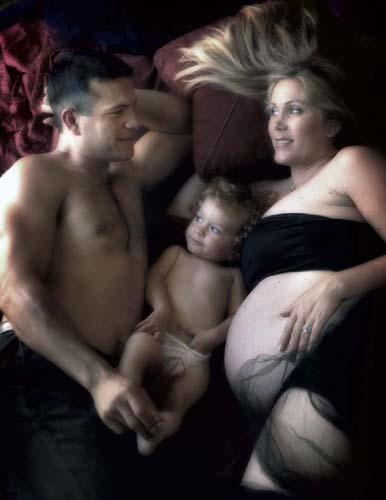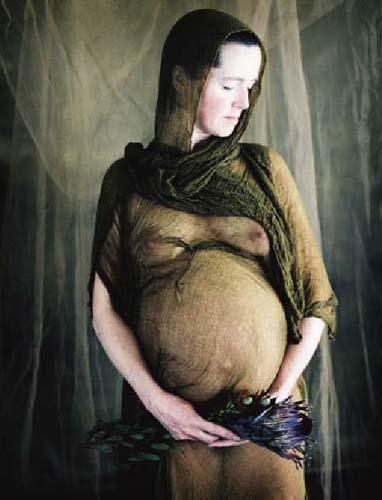The Art of Pregnancy Photography (5 page)
Read The Art of Pregnancy Photography Online
Authors: Jennifer George
Tags: #Health & Fitness, #Pregnancy & Childbirth, #Photography, #Subjects & Themes, #Portraits, #Techniques, #General
Sometimes having the child touch or listen to their mom’s tummy makes for a great, expressive image. The little girl in this portrait appears hesitant, not sure about all this, but wanting to be close to mom.

For the young sibling, Mom’s pregnancy may not be the best time. In this image, the child’s expression sends a clear message about her take on the pregnancy. Conversely, the mom’s expression conveys her contented state of mind.
When it’s time to begin photographing a mother-and-child portrait, remember that keeping the child close to mom will foster the feeling of protection. Step back and let the child interact with Mom naturally, while you quietly capture those moments.
Eliciting Expressions
. Capturing great expressions when photographing children takes practice and patience. We all should be able to hold a squeaky toy, tell a joke, or just act silly to get a big smile. The hard part is when you want something thoughtful or just plain adorable.
Sometimes the best images happen when you stay calm, just let the subjects be themselves, and capture the moment. Working in the home can be advantageous when small children are a part of the session—babies and toddlers are always more at ease in the familiar surroundings of their homes. Working on their turf can allow you to capture calm, sweet, and tranquil expressions.
Whether it’s fate, the temperament of the child, the relationship between the child and parent, or the baby is sick or teething or just not feeling well, there will be times when nothing you try will help you to get the child to cooperate and reward you with great expressions. In those situations, be flexible—and if need be, stop the session and try it another time. It would be prudent, however, to hand the child off to the father for a few minutes while you quickly capture a few images of the mother by herself, as you may not get the chance again.

Keeping the child close to Mom and Dad will ensure a calm, secure child.
3. PROPS, FABRICS, AND BACKGROUNDS
P
regnancy is an important stage in the human experience, and it should be the goal of the photographer to do more than simply document this phase of the subject’s life. It should be your goal to create portraits that express the subject’s mood, her nurturing qualities, and the quiet anticipation of the birth. The portraits should have a storytelling quality and should be free from objects that date the image.

It’s easy to create romantic and fantasy images when incorporating beautiful, richly colored and textured fabrics in your portraits.

Flowers and fabrics are the simplest and most appropriate additions to maternity portraits. Keeping props simple allows the viewer to focus their attention on the focal point of the image—the radiant subject.

Selecting fabrics that harmonized with the subjects’ skin tones and arranging them for the clients to lie on provided a great base for the image. Next, a background with the same tones was added. These simple steps can add tremendous impact to the image.

Selecting fabrics in the same color family keep the viewer focused on the reflective, nurturing mood exhibited by the subject.
In this chapter, we’ll take a look at some props, fabrics, and backgrounds that work well for pregnancy portraiture and add interest in the portrait without detracting from the viewer’s focus on the subject.
PROPS
Props have been used by photographers for over a century. Unfortunately, photographers can become so enamored with the overuse of props that the main objective of the image is lost. Props should always be used to enhance the image and should never distract the viewer’s attention from the subject. Again, simple is better when adding any element to an image, and it is especially true when using props.
Flowers are one of the most suitable props for maternity portraits. They are associated with feminine beauty and also symbolize growth and new beginnings. Having several types and shades of silk flowers on hand is a quick and easy way to add interest in an image.
Antique furniture and other objects that hold sentimental value for the subject may also be considered, so long as the objects do not date the image. Keep in mind that any furniture incorporated in the portrait should be darker than the subject and should not reflect the light. A quick visual scan of the overall scene should help you to identify and remove any distracting elements.
FABRICS
There are thousands of fabrics available today, but only those that are thin, lightweight, and have texture will work well as attire for your subject. Some of the most effective fabrics for draping over and around the human form are gauze, tulle, muslin, silk, crepe, stretch velvet, and chiffon. In the past, the color selection available for each of these fabric types was rather limited. Today, muslin is not just available in the traditional beige but in numerous colors too. For unique colors and textures in fabrics, look beyond the fabric stores and investigate upholstery shops. With the wide variety of fabrics available, your options are limited only by your imagination.
Gauze
. In the right-hand image on the facing page, the mom was wrapped in moss green gauze, which harmonized beautifully with the background and flowers. The fabric was wrapped tightly around her to show off her small figure and the perfect shape of her midriff.
Tulle
. If you plan to invest in only one type of fabric, tulle would be your best bet. Tulle is a soft, net-like material that is traditionally used for making wedding veils and dresses. It is also incredibly inexpensive and comes in a wide array of colors.
Because it is lightweight and thin, tulle is perfect for wrapping around the body. It can also be used to add dimension on the set. Randomly spread the tulle in uneven horizontal lines from the camera view. The tulle should create an undulating line to enhance the sense of depth in the image, as is shown in the left-hand image below.


Tulle can be used to drape the subject’s body, but don’t overlook the option of using it to add dimension in the overall image. The left image shows the effect of covering a bed in mounds of swirling fabrics. The right image shows how draping the fabric across the subject added interest and created a leading line that draws the viewer’s gaze to the subject’s face.